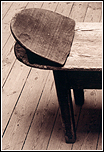 |
|
|

Un Tombeau pour Dame Obsolète by Graham Waterhouse This Tombeau touches on that notable historic rivalry in the early eighteenth century between the established viol and the new, four-stringed, fretless cello from Cremona. For some years the two instruments enjoyed similar prominence, but in time a number of eminent violists, notably the Saint-Sevan brothers, lay down their instruments in favour of the cello, which was to become the preferred instrument both for virtuosi and for continuo. The tombeau was a favourite form of Marais, amongst whose early works was a tombeau to his first teacher, Hottemann.
The Viole and the Harpsichord provide their own musical commentries, at times detached, elsewhere more involved and histrionically. At the end, they both perform a kind of élégie, gently re-asserting their pride as purveyors of the "female quality" of sound as against the "male quality" of the cello. Just as the Viol (as Le Blanc points out) had "annihalated the Harp of David", so the Violin and Violoncello were now userping the domains of the Basse Viol. Once again we bear witness to the perpetual flux in the tastes, techniques and fashions surrounding the instruments and the composers who wrote for them. The above photograph is by Jane Wildgoose by kind permission of The Old Operating Theatre Museum and Herb Garret, 9a St Thomas St, Southwark, London SE1 | |||||||
|
|
|
|
|






